
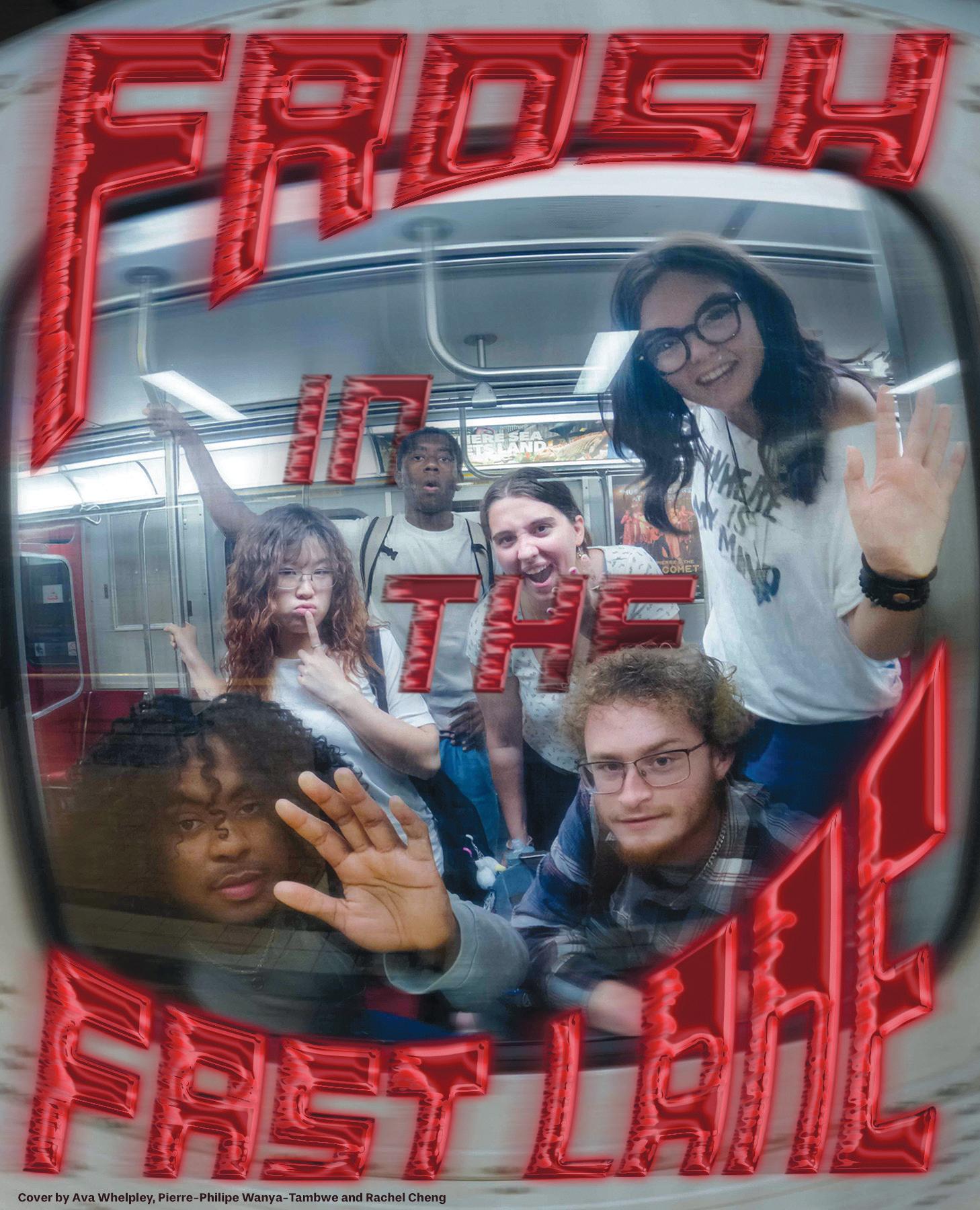
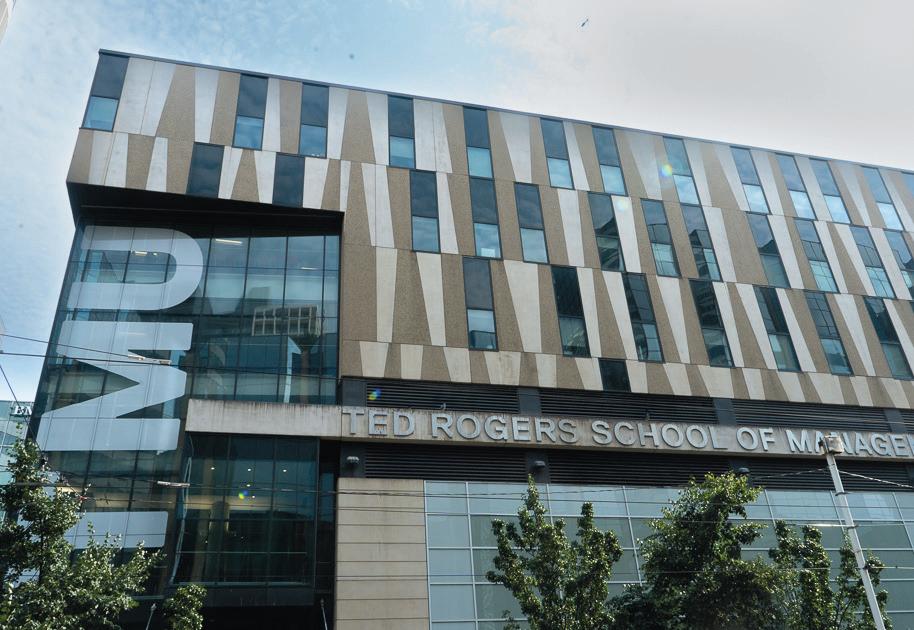




will increase student group funding to fill the financial gap
By Jasmine Makar
The Ted Rogers School of Management (TRSM) Dean’s Office is no longer offering an additional $76,000 in funding for student groups within the faculty for the 2025-2026 school year, with this source of funding previously being consistent.
Since the internal announcement and confirmation of this budget shift, the Ted Rogers Students’ Society (TRSS) has allocated additional funding for students to fill the gap created by the TRSM Dean’s Office, according to their Board of Directors’ meeting minute #5.
TRSS is also a source of funding for all 31 interest groups and course unions in TRSM.
Advocating for students and acting as the liaison between the faculty and students is a core part of their mission, as mentioned on their website.
“The Dean’s Office has confirmed that, due to university-wide budget reductions, base operating budgets will no longer be used to sponsor student groups,” the meeting minutes read. “This amounted to ~$76,000 in support.”
The announcement was made to student groups through an email on July 25, addressed to presidents and vice presidents of finance of
TRSM student groups. This email has been obtained and verified by The Eyeopener
“I regret to inform you that for the 2025-2026 academic year, we will not be using the base operating budget to sponsor any student groups,” the email from TRSM reads.
“When we got that email, it couldn’t have come at a worse time...”
The email written by Krista Vogt, executive director of TRSM Student Services and forwarded to student groups by TRSS, also includes reassurance from Ayden Santiago, a final-year law and business student and the president of TRSS.
“We understand this news may be disappointing…we want to reinforce that TRSS is currently planning how we can best support our student groups through this shift,” Santiago wrote at the end of the email.
Fourth-year business technology student, Luis Alitagtag, spoke about his frustration as the co-president of the Toronto Metropolitan Consulting Association (TMCA).
Previously, TMCA heavily relied on funding from the Dean’s Office for its initiatives, according to Alitagtag.
“I think it’s a slap in the face, given that we work closely with students, and we only want the best for them, but it seems like that isn’t being reciprocated through the school,” said Alitagtag.
TMCA, along with other groups, typically plan their funding and budgets in the summer, so the email was unexpected, considering they had consistently pulled from that source of funding before.
“When we got that email, it couldn’t have come at a worse time, because keep in mind, we were well into planning for the year…so to get that email mid-July just really caught us off guard, and we didn’t necessarily know how to rebound from that,” said Alitagtag.
When asked why these cuts were made, the TRSM Dean’s Office denied any budget cuts being made directly, instead stating that other funding avenues have not changed and are still available for students.
“To clarify, there is no cut; rather, the Dean’s Office at the Ted Rogers School will not be facilitating additional funding requests for student groups this coming academic year,” Toronto Metropolitan University (TMU) said in an email statement to The Eye.
In contrast, Santiago confirmed this budget shortfall and has ex-
pressed her frustration with the university’s decision.
“TRSS has taken steps to engage with the Dean’s Office following the announcement of the cut. We issued a formal email expressing our concerns and the need for transparency. We have requested a meeting with Krista Vogt, Executive Director of Student Services, to discuss the impact and rationale behind the funding cuts,” she said in an email statement to The Eye.
“The onus should have fallen on the Dean’s Office, the people in charge...”
When Alitagtag further enquired about the funding cut after the email announcement, he claimed they struggled to give him a clear response and “sounds like they’re just trying to add so much fluff to the situation when really, the bottom line is they’re not sponsoring us,” he said.
While waiting for this meeting to take place, TRSS confirmed in an email statement to The Eye that “in response to the removal of Dean’s Office sponsorship for student groups, [TRSS] has increased funding to student groups by over $100,000 for the 2025–2026 academic year.”
Alitagtag acknowledged the support being given by TRSS to fill the funding gap but explained that the responsibility shouldn’t fall on them.
“The onus should have fallen on the Dean’s Office, the people in charge, rather than a subsection of them,” he said.
Alitagtag further explained one of many suggestions from the Dean’s Office to bridge the funding gap is to rely more on corporate sponsors and external donors.
But in a time when there’s a “looming recession” and having to compete with 31 other student groups within TRSM, corporate sponsors are more difficult to acquire, he said.
The Dean’s Office has attributed this funding shortfall to universitywide budget cuts that require them to make difficult decisions, as stated in their email to student groups.
In their statement to The Eye, the university mentions the larger budget situation in more detail.
“TMU...is facing a very tough budget situation, stemming from declining government grants that have not kept pace with inflation or enrolment growth, a 10% tuition cut along with tuition being frozen since 2020-21, combined with the federal cap on international student visas, which has constrained revenue for the university.”

The Eyeopener is rebuilding trust and returning to weekly print in Vol. 59
By Negin Khodayari
Walking back into The Eyeopener’s newsroom after over a year away feels a little like stepping into a time capsule. The bulletin boards are still overflowing with mementos of past editors and almost every crevice of the room is covered with stickers—a sight I didn’t realize I missed until now. The fluorescent lights still buzz a little too loud and the shelves still sag under the weight of old issues. But every relic reminds me of our legacy on campus and the generations of editors, contributors, sources, readers and friends who have walked through these doors. This isn’t just a student publication. It’s a community. A responsibility. A platform. A voice for stories that too often go untold.
Since I last signed off in Volume 57, Toronto Metropolitan University (TMU) has seen some notable changes, both good and bad.
Earlier this year the school launched a new five-year academic plan—“Transforming Futures: TMU’s Vision for Academic Excellence”—co-created with over 1,600 community voices. It’s a roadmap promising progress in student success, equity, Indigenous partnerships and sustainability. The university also unveiled its first campus-wide Equity, Diversity and Inclusion Strategy and Action Plan, marking an institutional promise to finally address inequalities within the school.
The students’ union is changing too. This spring, the Toronto Metropolitan Students’ Union voided its 2025 general election after an investigation found the process “deeply compromised.” Several executives and directors have been suspended while independent investigators review allegations tied to the election and organization. It’s a messy, un-
certain moment for student leadership—but one that underscores why student journalism matters. We will be keeping a close eye on the union to ensure it remains accountable to the students it represents.
Change isn’t just coming through policy and governance—it’s etched into the campus skyline. Construction is underway on the new eightstorey Student Well-Being Centre, a modern addition to the historic O’Keefe House. This space will bring together counselling, medical care, health promotion and accommodations under one roof— an overdue investment in student wellness. Though not all feedback has been positive. Despite the university reassuring students that the historic face of the building will be preserved, some are skeptical of the changes. Some students have expressed they believe there is value in maintaining the character of spaces both indoor and out, as previously reported by The Eye
“This isn’t just a student publication. It’s a community”
Just down the street, the Lincoln Alexander School of Law is preparing to move into a landmark building at 277 Victoria St., we’ll be following that transition as it progresses.
And coming to campus this fall is SCITHub, the world’s first fully digitally integrated building which will serve as a living lab. The building’s construction cost was valued at approximately $7.5 million and was being funded by a combination of public grants and private donations, as previously reported by The Eye
Even academics are pushing boundaries in unexpected ways.
Just last month, The Creative School announced a course on Pun-
jabi singer-actor Diljit Dosanjh, set to launch in 2026—a reminder that culture and curriculum are increasingly intertwined.
But not all the change has been positive. Last fall, TMU announced it will be retracting its plan to reserve three quarters of available spots for equity-deserving applicants at its new School of Medicine. These students would have previously been applying through one of three admission streams: the Indigenous Admissions Pathway, the Black Admissions Pathway and the Equity-Deserving Admissions Pathway, as previously reported. The Eye will continue to report on the developments with the medical school admissions, especially in light of the university’s new Equity, Diversity and Inclusion Strategy and Action Plan described above.
More recently on Aug. 4, The Globe and Mail reported that the security company hired by TMU, is responsible for staffing ‘Alligator Alcatraz,’ a controversial immigration detention facility in the U.S. We are following this story closely and will keep you updated.
In short: TMU is evolving— physically, academically and socially. And with that evolution comes the need for fair, independent student journalism more than ever.
Beyond the confines of this campus, global crises—including the ongoing genocide in Palestine— still prevail. The Eye remains committed to reporting the truth affecting international communities. We will continue to cover events with accuracy, context and care.
Part of being a leader means acknowledging where you go wrong. As a publication, we haven’t always gotten it right. In the past, we’ve made some ill-considered judgments in our reporting and our readers have been loyal enough
The Eyeopener Masthead

Editor-in-Chief
Negin “Overheating” Khodayari
News Editors
Shumaila “Needs” Mubarak
Vihaan “School” Bhatnagar
Damola “Comment” Omole
Arts & Culture Editor
Lama “Red Carpet”Alshami
Business & Technology Editor
Jerry “-50 Kern!!” Zhang
Communities Editor
Daniel “3 stories” Opasinis
Features Editor
Edward “Paris” Lander
Fun & Satire Editor
Dylan “Been Here” Marks
Sports Editors
Jonathan “Locked” Reynoso
Victoria “In” Cha
Production Editors
Jasmine “Ruthless” Makar
Sarah “Salmon” Grishpul
to point them out. For that, we’re grateful. Mistakes are part of journalism but accountability is too. Now, with new energy and fresh perspectives, we’re renewing our promise of accuracy, fairness and journalistic standards.
This year, you can expect rigorous reporting from us—on university decisions, student stories, construction delays, union controversies, global unrest and beyond.
But you can also expect features that uplift and celebrate our community: the student entrepreneurs, the artists, the researchers and the activists who make TMU what it is.
That’s why I’ve returned as interim editor-in-chief (EIC)—and for me, this return carries special meaning. I’m proud and deeply honoured to be one of the only EIC’s in Eyeopener history to hold this role twice. Being trusted with this responsibility again isn’t something I take lightly. I know the weight of this position and the privilege of leading such a talented team of student journalists.
The Eye has shaped me as a journalist and as a person and stepping back into this role feels like both a homecoming and a challenge I’m eager to embrace.
And we’re making a big move of our own: The Eye is returning to weekly print. In a digital-first era, that decision may seem unusual but to us, the tangible matters. Print is more than ink on paper. It’s an art form. It’s a record. It’s something you can hold, share and shove into your backpack to read between classes—or never. We believe students still deserve that experience.
So here’s to another year of truthtelling, curiosity and chasing the next great story. TMU is changing.
So are we. But our goal remains the same: to serve students and piss off the right people.
Photo Editors
Ava “Sub” Whelpley
Rachel “Way” Cheng
Pierre-Philipe “Surfers” WanyaTambwe
Media Editors
Divine “Perfect Draft” Amayo
Lucas “Rough Draft” Bustinski
Digital Producer
Anthony “DJ Presto” Lippa-Hardy
Circulation Manager
Sherwin “Kart GOAT” Karimpoor
General Manager
Liane “BBQ” McLarty
Design Director
Vanessa “Tiny” Kauk
Contributors
Daniyah “#OpenToWork” Yaqoob
Mohammed “Which Section?” Mohyedin
Hannah “Understand The Grind” Sabaratnam
Tristan “Nepotism” Forde
Rogene “Support Student Artists” Teodoro
Aisha “Those are classics” Duldul
Omolegho “First Pic” Akhibi
Toastie “Please Adopt” Makar
Joshua “Reference” Chang
Madeline “Letter” Liao
Swamp “Devo” Monster
Blue “Winning” Jays
Lohamed “Big Boss” Machemi
Olivia “Sorbonne” Mills
Charlie “Hello Again” Vernis
Jo “Course Selection” Eng
Frankie “Froshie” Falcon
Toronto “Transit” Commission
Kagin “Homies” Nhodayari
Kanessa “Oopsies” Vauk
Jack “Sweetie Pie” Kauk
Address
55 Gould Street, Toronto, ON, M5B 15B, Suite 207

By Ava Whelpley
Toronto Metropolitan University (TMU) has a large population of students who live off-campus and commute to school. Commuter students say they have a harder time making friends, dealing with burnout and feeling motivated to engage in campus activities and events.
Commuter students make up 77 per cent of all students at TMU and 60 per cent of students who are disinterested in
engaging in campus activities and events, according to a 2019 survey done by StudentMoveTO.
Diana Brecher, the scholar-inresidence for positive psychology at TMU, described burnout in three parts. “It’s [firstly,] the notion of fatigue that comes from caring too much for too long and that’s completely subjective. So what might make you tired won’t make me tired or vice versa,” she said.
Burnout can affect commuter students immensely, though Al-
By Mohammed Mohyedin
Students at Toronto Metropolitan University (TMU) are starting the school year this September at two different crossroads: some are beginning their first year, while others are preparing for their last.
For first-years, stepping on campus marks a season of new beginnings. It’s a leap towards independence and a chance to redefine themselves from their time spent in high-school or work.
For students in their final year, it’s a moment to look back on the university years that built them. From friendships made and challenges overcome to the unexpected turns that may have arisen throughout their journeys.
For fourth-year marketing student, Marlen James, university has been about pushing himself out of his comfort zone and embracing the opportunities that come his way.
“I wanted to make the most of it because this is it, there’s no more schooling after this for me,” said James. “I wanted to take as much information, meet as many people and do as many things as I could.”
That urgency to embrace it all has been his compass. “While you’re [in university], take advantage of everything that comes to you, because there’s
going to come a time [when] you graduate.”
Incoming first-year professional communication student Aaisha Arshad said she chose TMU for its community-based environment and the opportunities she could see herself thriving in.
“I love how social it is,” she explained, adding that her program felt like “the perfect in-between” after weighing the choice between business or English studies. “It offers so much and the courses are super interesting; I just knew it was for me.”
Arshad views university as a fresh start. She’s already mapping out the clubs she wants to join, the events she hopes to attend and the courses she’s most curious about.
She’s especially drawn to the idea of working on collaborative projects and public speaking opportunities within her program. “I want to challenge myself to go beyond my comfort zone,” she said. “If I can look back at the end of the year and see that I’ve tried things I never would have before, then I’ll know I’ve done it right.”
For fourth-year retail management student Shiyami Seralathan, the journey has been about adapting to the unexpected. Starting her studies during COVID-19 meant missing the in-person ex-
on the subway.”
Many commuter students at TMU struggle to find a reason to stay on campus outside of class.
Third-year chemical engineering student Ryan Harding said he “found it hard to make…deeper connections with people.” He says since students live all across the city, it can be challenging to get together.
The second key part of burnout “has to do with a depletion of empathy and a depletion of compassion,” Brecher continued, sharing that a disconnect can form between friends, colleagues or even family.
exander Hall, a third-year professional music student who commutes one hour from the Durham Region, explains how he has managed to cope. “Sleep is lowkey your best friend…the best thing I’d say for now is to give yourself rest.”
Other students, like Elly Kopyto, a second-year double majoring in criminology and sociology, have found a way to optimize their commute to increase productivity. “If it’s a philosophy class or something, I’ll read my book


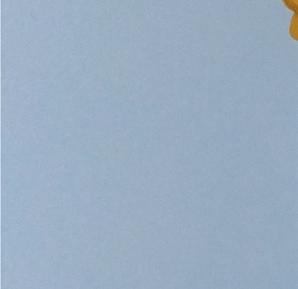




perience. “I assumed I would be very, very confident,” she said, “but then when I started, we were online due to COVID, I did get a little nervous, just because I know first year is where you make all your friends but for us, it was a little bit different.”
A major turning point came with a class trip [RMG 917: Experiential Learning Travel Study] abroad to Dubai. “I felt like it was a dream… I felt like seeing the world from a different point of view…that was really interesting for me.”
She now makes it a point to attend every class and connect with professors and peers. Her advice to new students: “Make lots of friends, talk to your profs, ask all the questions you want, just don’t be scared to ask for help,
events. For example, events can be found on department/faculty websites such as the faculty of arts page, a list of student groups can be found under the Toronto Metropolitan Students’ Union page and there are plenty of classes and drop-in programs accessible on TMU’s Recreation & Active Wellbeing page.
She also encouraged students to take 20 minutes to do something, anything, three times a week, claiming many students found a significant amount of improvement in their sleep, mood and energy levels.
Another struggle a commuter student faces is the lack of spaces available for socializing.
Kopyto who previously attended Concordia University explained how, as a first-year student there, they were given many flyers with opportunities to join and engage in campus activities and events but feels TMU has not offered as much. Instead, they simply commute back home after classes.
Brecher’s third key part of burnout “is this decreased sense of accomplishment, where you feel like everything is futile, nothing you do seems to make a difference,” she said.
To avoid falling through the stages of burnout, Brecher outlined a few ways to stay familiar with campus activities and




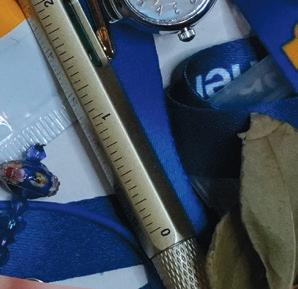
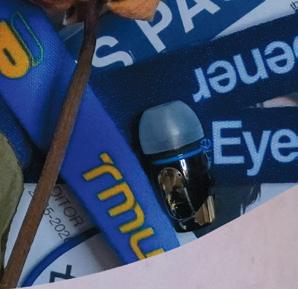

because everyone needs help at the end of the day.”
First-year computer science student Annber Christene Verginon is also beginning her journey at TMU, though it wasn’t her initial path. “I applied for both architecture and computer science,” she shared. “I got into computer science, so now I’m seeing where this takes me.”
While getting into her second choice wasn’t expected, she’s embracing it with curiosity. “I’m interested in design and building things, and in a way, programming is another form of creation,” she said.
She’s looking forward to exploring coding, joining tech-focused clubs and connecting with peers who share her interests.
Harding explained that most of the campus is underutilized by commuter students but these spaces are designed for studying, “I think most of the spaces in TMU could be tweaked a little more for social interaction.”
Despite this, Harding explained that the SLC is a good spot for socializing with friends. A guide to other campus hangout spots can be found on The Eyeopener’s website.
“If you’re smart, you’re gonna figure out what’s essential,” Brecher said. “Finishing that project or writing that exam is essential. Attending that extracurricular activity is probably really important and is going to help you with stamina to keep going.”




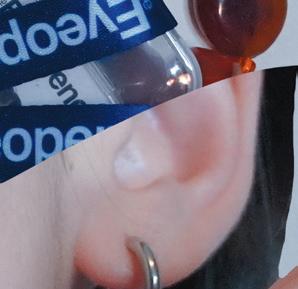


Back home, she had a large network of friends and a familiar environment. Now, she’s stepping into an entirely new setting where she’s eager to build those connections again. For Verginon, that means seeking out new friendships, joining activities and finding her place within the TMU community. While computer science was not her original plan, her focus this year is on adapting to the coursework, learning new skills and creating a support system on campus. “This year is about finding out what I’m good at and how I can use those skills in the future,” she said. It’s a journey she didn’t expect but one she’s ready to make her own.
Read more at theeyeopener.com

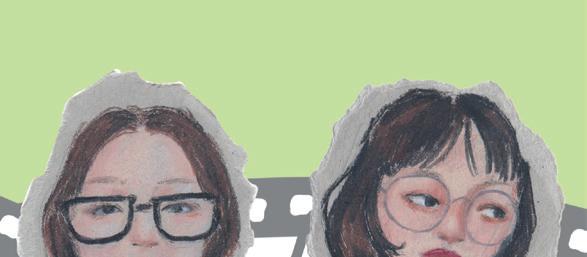




By Rogene Teodoro
The summer break offers students the opportunity to spend time away from their studies. While many use it for fun activities, such as trips abroad, some student artists take advantage of the time to develop their portfolios or gain work experience.
Fourth-year RTA media production students, Amanda Hu, Sydney Leggatt, Keisha Amigleo and Neila Flores came together to found Starfall Pictures. Since Janu-
ary, they’ve been preparing to film the pilot of their upcoming show, Love, TBD. A time travel rom-com taking place in the early 2000s where protagonist, Evangeline, encounters a novel that sends her five years into the past. There, she meets and bonds with her love interest, Jacob, before returning to the present.
Since forming their team, the quartet have completed a 15-minute script and looked into inspiration for their visuals. This summer they have been busy casting
for their project, looking for main characters and secondary roles.
Art director and co-writer, Keisha Amigleo, explained that the summer break “gives me time to really sit down and develop ideas and stuff that I want to work on.”
This includes “building on certain concepts, like Love, TBD to really make it something that you’re proud of that you can put on your portfolio later on.”
For Raphael Schmitz Mayer, a fifth-year marketing management student and guitarist, this summer is all about “trying to perform with as many artists as I can and also performing in a lot of places.”
Throughout the season, Mayer has played in places he never thought he would be able to, including The Drake Hotel and Sneaky Dee’s.
In terms of performing, “summer opens way more doors,” Mayer said. “Everybody’s more open to go out and to go to a bar to have a drink and even [go] outside to watch anything that is going on.”
Currently, he is gearing up for The 6ix Strings, an acoustic showcase of multiple artists that he has organized this summer.
To prepare, Mayer has been networking and reaching out to musicians, promoting The 6ix Strings on Instagram and rehearsing his songs.
If the showcase goes well, “I’m going to try to do it once a month,” said Mayer.
Passion projects like performances are an opportunity to gain work experience and connections with other members of their community. Such is the case for third-year performance acting student, Emily Fang.
Going into the acting program, Fang said she didn’t have much experience in the industry like her classmates, who were enrolled in acting classes or schools. Her only experience included the small shows performed by her public school drama class.
The summer break gave her a chance to create demo-reels and act in short films, allowing her to get out of her comfort zone. “Actually collaborating with different people from the performance field felt really nice,” she said.
One of those short films, Josie <3 , is a slasher-horror about a group of friends who go into the woods to celebrate their graduation. While burning their old schoolwork, they are greeted by an uninvited guest.
Fang said working on the film allowed her to network with people in the industry, build her experience and expand her acting portfolio. “It definitely gave me a lot more space to figure out what my next steps were,” she said.
Madeline Hanitijo, a fourth-year new media student, had a similar experience in the video game development industry.
Hanitijo is working alongside their friends to create a tactical role-playing game with the working title, Project Iron. As the lead artist, Hanitijo focuses on animating characters and managing the art direction.
She’s previously created video games solo but this summer marks the first time they’ve been able to take on a larger game development project by working with some friends.
“Lots of people dream of making games and then give up because it’s so taxing,” Hanitijo said. “Being able to work with likeminded individuals who are passionate about the project makes it so that we can make bigger things. But also that we’re motivated longer.”
As a fourth-year student, Hanitijo said they were worried about not getting hired after graduation. “I think doing this game was my way of seeing what it would be like to be an indie game developer,” they said.
Although she said money is not guaranteed, she gets her own flexible schedule and time to work with other people. More importantly, the experience is helping them have a broader view of what they can do in the future.

From romances to classics, these films capture the perfect summer vibe
By Aisha Duldul
As the freedom that comes with summer starts to slip away and the looming deadlines start to creep in, students are in the perfect spot to squeeze in a few last movie nights before the semester takes over. These seven picks bring laughter, comfort and the inspiration you need to wrap up the summer on the right note.
One of Them Days (2025)
SZA and Keke Palmer team up for a chaotic buddy film about two best friends/roommates as they scrape together rent, juggle bills and attempt to survive new jobs and new beginnings. The pair have to figure out a way to make an absurd amount of money in a short amount of time to keep their apartment. This movie is definitely for hustlers, friends and people who want a good laugh. It’s
loud, messy and relatable to anyone who’s ever been broke but still keeps pushing through.
White Men Can’t Jump (2023)
Jack Harlow and Sinqua Walls hit the court as two totally different basketball players who might have more in common than they think in this sports comedy. Their oneon-one games help them keep the cash flowing, but not without some consequences. This fresh take on the 90s classic serves up sun-soaked Los Angeles energy and big summer vibes, as the two men play ball, figure out family drama and deal with past injuries. A total slam dunk for your end-of-summer watchlist.
Booksmart (2019)
On the eve of their high school graduation, overachieving best friends, Molly and Amy, decide to make up for all the time they’ve
spent studying by cramming four years worth of fun into one night. This coming-of-age comedy is filled with loads of chaos, laughter and unexpected events along the way. A must-watch for anyone who’s been in this exact position, especially during the last few weeks of summer. Best enjoyed with your funniest friend or family member and a pile of snacks!
(500) Days of Summer (2009)
A smart, heartfelt look on love, timing and self-reflection in this romance by Marc Webb. Tom is a hopeless romantic who reminisces on the 500 days he spent with his girlfriend, Summer, before she suddenly broke up with him. Reevaluating all the moments he shared with her and trying to piece together what went wrong, he attempts to prove to her that love is real. A movie that will definitely have you
rethinking your current opinions on love and dating.
Mamma Mia! (2008)
Set on the fictional Greek island of Kalokairi, this classic jukebox musical follows a young Sophie as she prepares for her wedding. With the aim of finding her biological father, she secretly invites three men from her mother’s past, hoping to resolve the mystery before the big day and have one of them walk her down the aisle. With chaos, tender moments and humor, this film will take you on an emotional rollercoaster, the kind that is more fun to share with friends or family.
Do the Right Thing (1989)
Spike Lee’s iconic dramedy takes place on one scorching hot summer day in a Brooklyn neighbourhood, following locals as they juggle work, relationships and ev-
eryday life. When, racial tensions mount between a business owner and the community, the neighborhood erupts into conflict. Unfolding entirely over the course of a single day, the film delivers a poignant look at racism, inequality and the heat of social unrest, making it as thought-provoking as it is unforgettable. Whether you’re diving into a rom-com, a heated drama or escaping to an adventure on a European island, these movies perfectly capture that bittersweet moment between the end of summer and the start of something new. So gather your friends, put your phone on ‘Do Not Disturb,’ stock up on your favourite chips and candies and settle in for a great movie. After all, that is what summer is all about.
Read more at theeyeopener.com
Pick up a new issue of The Eyeopener on stands
Tell us your favourite travelling mishap from this summer
Hit submit! Google form closes end-ofday on Sept. 17
Follow us on Instagram and keep an eye out. The winning story will be posted on Sept. 18




The Eyeopener
We are dedicated to reporting on the stories that matter here at TMU. Visit our office in the Student Campus Centre (SCC207) or email editor@theeyeopener. com if you’d like to come forward with a potential story. If you’re someone who’s interested in volunteer opportunities with us, shoot us a message on any of our platforms!
Community Safety and Security
In all emergency situations, call 911. In other circumstances, call campus security at 416-979-5040 if you see something that needs to be checked out. This is the number for WalkSafe as well. You can email them at walksafe@torontomu.ca.
TMU Human Rights Services
For discrimination and harrassment complaints or sexual violence complaints, call 416-979-5349 or email humanrights@ torontomu.ca.
TMU Medical Clinic
Email medicalct@torontomu.ca or call 416-979-5070 for support. Call 911 in all emergencies.
Ombudsperson’s Office
Confidential help for students who need it when dealing with the university’s systems and processes. Call 416-979-5000 ext. 557450 or email ombuds@torontomu.ca.
Student Learning Support
For academic support and tutors, call 416-598-5978 or email slls@torontomu.ca.
Library
For material and search advice call 416-979-5055.
Academics
For academic help, questions and concerns, visit torontomu.ca/contact/student/academic_contacts.
Accommodations for students with disabilities
Email aasadmin@torontomu.ca or call 416979-5290.
Academic appeals
Have a problem with your grades? Visit yourtmsu.ca/services/academic-advocacy.
Legal help - free legal advice
Academic Important Date
Date
for work compared to previous years. Where 15 to 19-year-olds spent eight weeks looking for a job in 2019, they are now spending 15 weeks to do the same in 2025. Those aged 20 to 24 spent an average of 17 weeks looking for work in 2025 compared to 10 weeks in 2019.
This summer, in the absence
ment rate during a student’s year of graduation is associated with a 0.7 per cent decline in earnings for five years after graduation. Similar research quoted by The King’s Trust Canada found that a period of unemployment lasting more than six months for someone at 22-years-old could see an
Words by Daniyah Yaqoob
Visuals by Rachel Cheng
As students struggle to find work in a tumultuous job market, they worry for their finances—and their futures
ON A HOT MID-JULY afternoon, Daksh (Dash) Patel walks into a downtown Toronto Chipotle franchise with one goal in mind: he’s going to get himself a job.
As he enters the restaurant, he feels a sense of assuredness. The dining room is bustling with activity while staff barely manage the barrage of burrito orders. With his skills and their shorthandedness, the job will be almost guaranteed, he thinks to himself.
Patel—a recent environmental sciences graduate from the University of Toronto—had applied to hundreds of jobs in his field of study, but every single one either ghosted his application or sent him a rejection email. He might as well have memorized the standard template, each a disappointing variation of, “Sorry, we’ve gone with another candidate for the position.”
A few months after graduation, Patel had come to terms with the reality that he’d have to apply for jobs outside his field and—despite his qualifications—he’d need to seek out part-time work in the service industry.
After a five-minute wait, the hiring manager walks into the dining room, clipboard in hand. Patel spots something in her hand—a stack of resumes, centimetres thick. As he eyes it, his expectations begin to lower.
He soon finds out that the interview—which he’ll be giving alongside another candidate—will take place in the middle of the crowded restaurant. Nevertheless, he tries to keep his hopes up.
“What’s your availability?” asks the manager, raising her voice
slightly to be heard over the patrons.
The interview lasts around 20 minutes. When it’s over, the hiring manager tells him to expect a response within three days on the online recruitment service the restaurant employs—fittingly named ‘Avocado.’ Three weeks later, he still hadn’t heard back.

“That made me realize…no wonder it’s been hard for me,” Patel says. “It’s bad for everyone else.”
At the time of the interview, Patel had already made the decision to go back to school. He’d been accepted into Toronto Metropolitan University’s (TMU) civil engineering program, and will be attending this September. He’s now hoping the additional qualification will make it easier for him to find a job.
Traditionally, summer is a time for students to work, build their soft skills and add to their savings. But this summer that’s been much harder to do.
Right now, young Canadians from coast to coast are facing an unemployment rate of 14.6 per cent, the highest since 2010 if you exclude the pandemic years. In Ontario, it’s even higher, with a rate of 15.8 per cent for those aged 15 to 24. And among university students who are returning this fall, the rate is a staggering 17.4 per cent.
Hilary Hagar, a research and evaluation assistant at the Future Skills Centre (FSC), an organization that researches Canada’s changing labour market, says the youth unemployment crisis—as many now call it—will have farreaching consequences on both the individuals facing it and the economy at large. From financial instability to effects on mental well-being, sparse job opportunities for Canadian students now
will only lead to more struggle in their futures.
Dressed in her best business-casual attire, Wynona Fernandes, an incoming TMU first-year student, watches the other candidates at a group interview for a position at Cineplex fiddle with their resumes and twitch with anxiety. The bustle of the mall where the theatre is located sets the tone on that early January morning. Fernandes is confident about her chances—she has years of volunteer work to back her and a three-month job experience that she learned valuable skills from. But in speaking with her fellow candidates, she realizes the range of people competing for the same position as her—high school students, college graduates, even a former amusement park manager. Her confidence when entering the interview quickly wanes.
The hiring manager tells her she’ll be contacted by the end of the week if she gets the job. She waits anxiously, until the end of the week comes and the next week begins, and hears nothing.
“It can be a little disheartening at times,” she says.
of a job, TMU computer science graduate Choyon Uddin spent his mornings doing chores— from taking care of the lawn to running errands for his parents. In the evenings, he meets with friends or spends hours at the gym. During the day, he works on coding projects, ensuring his computer science skills do not dull and that when, hopefully, employers respond to his applications, he’ll have more experience under his belt. He also constantly finds himself scrolling through LinkedIn, which Uddin refers to as “corporate Instagram.”
It’s during the night, from 11 p.m. to 3 a.m. that he sits down for “admin tasks” like applying to jobs, working on his resume and making connections. He signs up for job fairs on Eventbrite—his friends send each other job opportunities they come across. Uddin has push notifications for LinkedIn job openings, many of which go up at night. Even within half an hour of an opening, Uddin notices hundreds of applicants have already submitted their resumes for consideration. Since May, he has applied to around 500 jobs—but until a recent successful application, he had never made it past the interview stage.
For Uddin, finances top his list of concerns.
average reduction of eight per cent in their wage by age 23. This is a phenomenon referred to as “wage scarring” and can prolong the path to financial independence.
While Uddin personally hasn’t faced pressure from his parents to become financially independent, it’s something many youth desire. A recent report from the Toronto Youth Cabinet, a non-partisan organization that advocates for Toronto’s youth, found that 64 per cent of young people said a job would reduce their dependence on their parents.

Fernandes, who will be studying urban planning this September, graduated high school in 2024. After deciding to hold off on pursuing a degree, she had turned her attention to looking for work. Having been in the trenches of the job market for a while, she’s noticed things worsen over the years.
Uddin, on the other hand, is now “numb” to rejections—he’s applied to more than 3,000 jobs in the last two years
“I racked up student debts, right? So that… on top of going out, spending money with friends and whatnot… it racks up,” he says.
Hagar says it’s not just paying for expenses today that’s concerning these students—data shows that unemployment now can affect earnings later in life.
Whenever Fernandes leaves the house, she keeps an eye out for ‘help wanted’ posters. She’ll snap photos of each one that she comes across, saving it for later review. She keeps a resume on her, in case she comes across someone hiring who might take it—which isn’t often anymore.
Much of her commute to Rogers Centre—where she currently holds a seasonal position that will soon be wrapping up—is spent pursuing online job postings and making adjustments to her resume. As soon as she’s home from work, she has her parents or friends review her applications before submitting. But after months of cold-calling and applications—over 60 in total—have yielded nothing for her.

“Even when I did apply for jobs throughout high school, [employers] were getting back to me,” she says. “But now, it’s just the amount of applicants that they get. You’re not getting anything back.”
Data from the Canadian Centre for Policy Alternatives shows that on average, young Ontarians are spending more time searching
“Unemployment when people are first starting their careers, whether it’s in high school or in post-secondary or just graduating post-secondary can have scarring effects for years to come,” Hagar says. “So this can impact someone’s career progressions.”
Research from FSC indicates that a one per cent increase in the provincial youth unemploy-
There are a few things that factor into why it has become harder for young Canadians to find jobs. According to The King’s Trust Canada, the increase in unemployment is a result of more people entering the workforce, while the number of available jobs hasn’t grown.
Hagar says that many part-time opportunities that youth tend to gravitate towards—like cashiers, clerical workers and servers—are susceptible to automation. Research that FSC did in Quebec found that 18 per cent of the workforce is vulnerable to automation either by robotization or artificial intelligence.
“Even large companies we
know, like Shopify, OpenText, are scaling back their hiring and recruitment programs because a lot of the work that would be done by, say, a junior analyst, a summer student, somebody fresh out of college or university is now being
lenges faced by specific groups of young people amidst the unemployment crisis. Indigenous youth continue to face stereotypes and prejudices while finding work.
Racialized youth face hurdles in the form of microaggressions and discrimination. Youth with disabilities face barriers within society that either don’t accommodate their needs or make them hesitant to disclose them.
Hagar says more focused work must be done to address the unique struggles all of these young people
being fruitless. “I was very frustrated, especially since I wanted to make money,” he says.
Hernandez eventually realized that if he wanted to secure his financial independence, he would need to try something different.

done by technology, because that’s cheaper,” Hagar says.
The elimination of entrylevel positions causes a chain reaction. When youth can’t find jobs to sharpen their skills or get the experience that every employer seems to require, it’s harder to get their foot in the door anywhere, Hagar says.
Uddin has found himself in this age-old predicament multiple times: to find employment, he needs experience. To get experience, he needs to be employed.
“I remember seeing a big company posting for an internship role and they were expecting two to five years of experience. That makes absolutely no sense,” he says. “Even if you work every single summer, you wouldn’t get two years of experience.”
Hagar says that though many are quick to speculate that an influx of international students and newcomers is the problem, data doesn’t necessarily back that theory.
face in finding employment, for real progress to occur.
Hagar says right now, policy isn’t addressing the long-term consequences of the youth unemployment rate. She suggests advancements in career guidance systems for young people and steps towards integrated learning between universities and industries could improve their chances of success in the future.
Iapplied to more than 3,000 jobs in the last two years. He says he now “speed reads” emails letting him know his application wasn’t successful. Instead of dwelling on it, he stays positive and simply moves on to the next opportunity.
“People are just trying to get hired no matter what the job is”
A group of his friends had started a cleaning business one summer, and he was now eager to get involved. He had manual labour experience in the past—working in construction for his father—and this could be his opportunity to finally get working. He went for it.
Instead of spending a third summer waiting for rejections to hit his inbox, Hernandez is now going door-to-door offering win-
But while he’s been able to carve out a good attitude surrounding rejection, he can’t deny the social impacts of unemployment.
At a family wedding in San Francisco this summer, Uddin was surrounded by relatives and friends a few years older than him—all of whom were holding down jobs.
Uddin didn’t feel looked down upon for his joblessness though—in fact, the guests empathized with his situation— but the experience still made him want to find work as soon as possible.
“I was the only one there without a job. And I was like, ‘wow, this kind of sucks,’” Uddin says.

According to Indeed Hiring Lab, even when there was a surge in newcomers, it wasn’t accompanied by a surge in people working. In fact, youth newcomers and international students have limited access to the job market on top of cultural and linguistic challenges they may face.
n the summer before he enters Grade 11, Aaron Hernandez, now an incoming TMU electrical engineering student, sits in the quiet of his local library in Richmond Hill. His fingers sweep across the keyboard of his laptop as he drafts resumes and cover letters. It’s a motivated and eager pursuit.
Many told him if he puts in the effort, he’s guaranteed an interview. He spends time carefully tailoring each resume to the specific place he’s applying to—even if it’s a general position at Walmart or a line cook.
On a frigid night at the beginning of the year, Patel wakes up on the floor of his bathroom. His parents, looking concerned, are hovering over him. They tell him he passed out.

dow cleaning services. His schedule is his to decide and the profits— which he makes a fair bit of—are his to spend. He doesn’t see himself returning to the world of job applications any time soon when blue collar work has been a “rewarding” way to support himself.
According to Hagar, “People get so much more than just a paycheque from a job. We know there’s a sense of purpose and well-being people get from their work. Not to ignore the tangible things as well, like mental health benefits, dental benefits, extended health benefits.”

Newcomers and international students aren’t the only group facing additional obstacles.
The King’s Trust Canada report also addressed unique chal-
But as the summer passes him by, he doesn’t hear back from employers. Hernandez decides to call it quits and try again next summer—it too ends up
Fernandes—who remains without work—is familiar with the impact joblessness can have on a person’s well-being.
“With your resume, you’re putting your best of your best out there… and sending it to hundreds of people,” she says. “It can definitely be a bit of a mental toll on me, putting in the effort and not getting anything back.”
Patel knows exactly what’s happened—it’s happened before. He stayed up too late, drank too much coffee and his body reached a breaking point.
On most days this summer, Patel’s routine has looked the same. He gets up, brushes his teeth and settles into his living room to apply for jobs. The first half of his days are spent with his hand resting over the right-click button, saving job postings he comes across. The latter halves are spent adjusting his resume and sending them off to employers.
Finding work has become a 9 to 5 job for Patel in the absence of a paid gig—to the point that his physical health has also become a victim to the stress of a nightmarish job market. His parents notice the stress, his doctor notices and even his dentist—who says his teeth are being stained by excessive coffee—notices.
While these students’ plans looked solid as children—Patel dreamed his degree would get him a job in the sciences and Fernandes just dreamed of working at all—they’ve been forced to pivot in the face of an uncertain job market.
“People are just trying to get hired no matter what the job is,” Fernandes says. “Just because of how bad it is out there.”
Patel has submitted more than 500 applications in the span of a few months—with little to show for it. But still, tomorrow will be rinse and repeat.

Uddin, on the other hand, is now “numb” to rejections—he’s
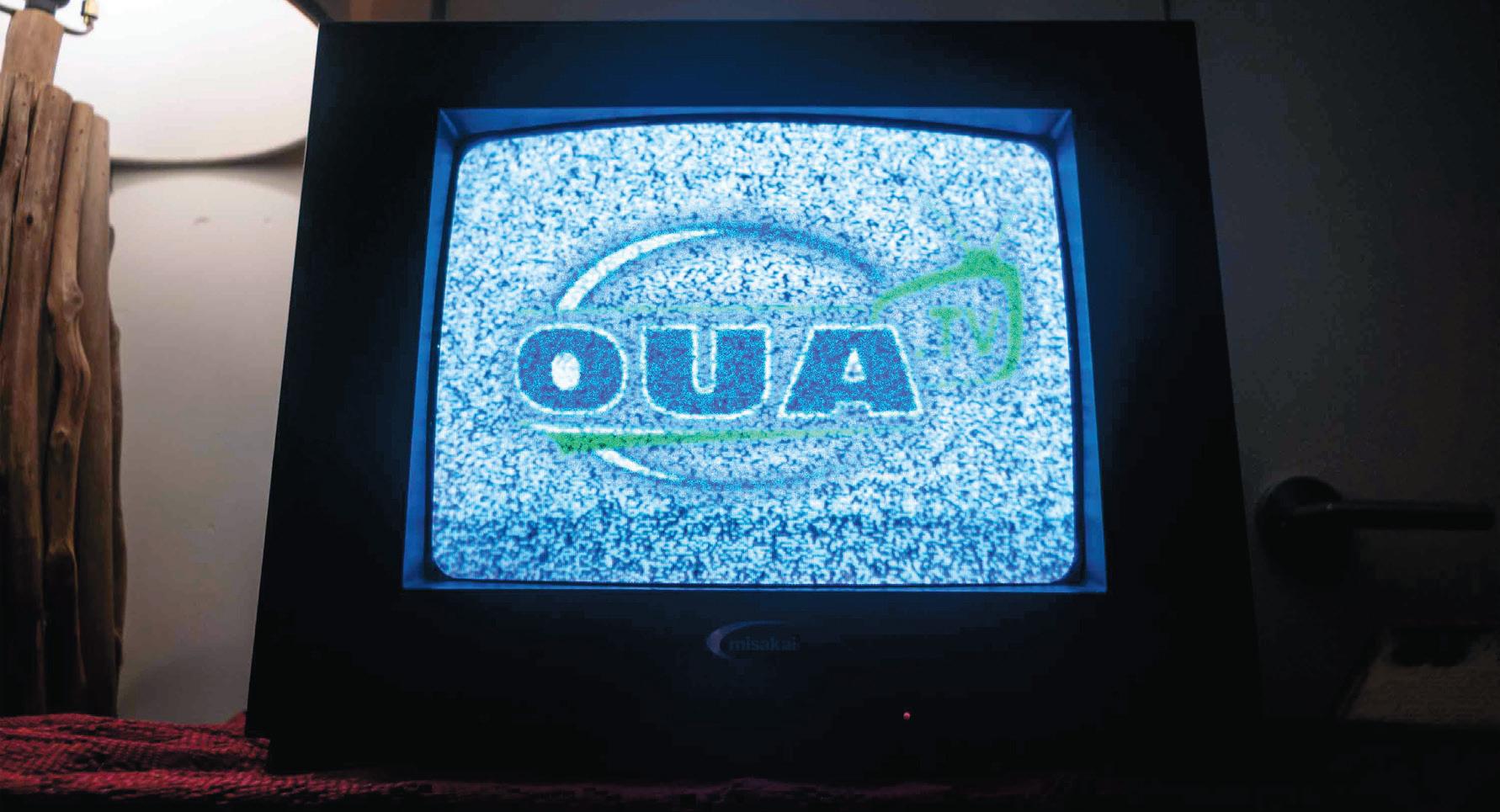
The OUA is now charging users to stream certain varsity sports
By Tristan Forde
Since its creation in 2014, fans of Ontario University Athletics (OUA) have had free uninterrupted access to varsity-level sports all across Ontario via its streaming website OUA.tv.
Initially formed through a partnership between the OUA and multimedia streaming company Stretch Internet, which has since been acquired by PrestoSports, OUA.tv was a free-to-register streaming platform where fans could watch university-level sports from all 20 OUA member institutions.
This all changed one afternoon, on June 26, with a post from the official OUA Instagram account announcing the introduction of purchased sport passes for hockey, basketball and football.
OUA.tv users must now choose between three different paid pass
options: $8.99 for a single game, $39.99 for a full season access for a single sport and $89.99 for complete access to all three sports for the 2025-26 season.
The implementation of this paywall has come as an inconvenience for many students, fans and families of the teams who wish to watch these sports virtually.
“It’s just a big question as to where the money goes”
One of the many demographics of students affected by this can be found within the Toronto Metropolitan University (TMU) sport media program, including second-year sport media student Kolby Marsh.
“[The fee is] going to be a big inconvenience,” said Marsh. “If I want to go back and watch what
I’m doing or watch what I’m saying, I’m basically paying to go over my own footage.”
Marsh carries almost two years’ worth of experience in the realm of sports reporting, having spent the previous year working with the TMU Bold as an on-air commentator.
With both the 2025-26 sports season and impending paywall approaching, the viewership and outreach available for sports commentators will be limited.
“Whenever I was on a TMU broadcast, my parents were able to just log in to OUA.tv easily and be able to watch me commentate,” said Marsh.
Following the announcement post on Instagram, there were over 60 comments sharing the disdain for this shift in streaming models. Having had over a decade of free access to OUA
By Hannah Sabaratnam
As a new school year begins, so will a new era of Bold leadership at Toronto Metropolitan University (TMU).
Back in July, Louise Cowin retired from her position as executive director of Athletics and Recreation after serving the department for six years. The organization’s leadership structure will now consist of a twoperson model with Nick Asquini becoming director of athletics after two decades with the department and Andrew Pettit remaining as director of recreation, equity and active well-being.
In a press release made on June 30, the Bold thanked Cowin for her “transformational leadership and dedication to studentathletes, coaches, and the broader TMU community.”
Pettit’s role will stay the same but will have greater responsibility within the department. Both Pettit and Asquini will directly
a new face to its headship
report to Jen McMillen, viceprovost, students.
Before Cowin entered her position in 2019, TMU Athletics and Recreation already had flashes of success, including the women’s volleyball team earning the school’s first U Sports National Championship in 2018, setting the stage for her leadership to continue to foster the growth of the department.
However, during the 2019-20 school year—the first in her new position—Cowin, along with the rest of the school’s leadership staff, would face the enormous challenge of the COVID-19 pandemic. With TMU’s campus shut down, there would be empty weightrooms, no intramurals and cancelled sports games.
“This is where [Cowin’s] leadership I think really [stood out] for us and institutionally, TMU I think did really well for our students and for our staff,” said Pettit.
sports for all, this change came as a shock to many.
Marsh explained that it caused quite a stir amongst the sports media student community at the university.
With both basketball and hockey being two of TMU Bold’s best performing sports in the previous season—the men’s and women’s teams of both sports made it to the OUA playoffs—and TMU commonly being referred to as “a commuter school,” this paywall poses a problem for students who live a large distance from campus and cannot attend games in person.
Throughout its lifespan, the streams found on OUA.tv have been known to vary in quality, entirely reliant on the amount of funding each school puts into their media teams.
“If the broadcast is subpar it won’t keep fans engaged,” said Marsh. “Maybe that’s where the subscription money can be allocated.”
While some schools have complete camera sets and media teams managing game broadcasts, others simply have a tablet on a tripod. The new paywall may be an indicator that OUA hopes to bring more revenue.
“It’s just a big question as to where the money goes,” said Marsh.
Former Guelph Gryphons lacrosse attacker and marketing management alum Ben Doherty believes that this model could be effective depending on what the money will be used for.
“I do understand that everything is a business, it’s hard to put on the production and have all that value without having any money in return,” said Doherty.
This subscription service also comes with the opportunity for fans to engage with other
sports found on the OUA.tv platform. With a plethora of other sports such as lacrosse, or volleyball and soccer—the remaining two TMU varsity sports—remaining unaffected by the paywall and remaining free to watch online, the paywall “might push people that are just cheering for the university itself to explore other options,” said Doherty.
Alongside the launch of this new pay model, OUA announced the release of an official OUA.tv mobile app for IOS and Android, which will offer a more portable and stabilized version of the same desktop or TV streaming experience.
“If the broadcast is subpar it won’t keep fans engaged,”
“[The mobile app is] definitely there, it’s going to get noticed, it’s just if everyone will actually take that initiative,” said Marsh. “It’s something that we can’t really predict until the OUA season drops.”
When downloading the app and setting up an account, there is an option to select your user type from a variety of options, such as student, coach, media and administrator. Whether this new app will carry any sort of effect on the website will only be revealed once the sports seasons progress. With very mixed opinions, and a cloud of confusion, OUA fans and university students alike can only wait for the season to start to see what comes of this new model.
“Hopefully it works out well and it ends up pushing Canadian sports in the right direction,” said Doherty.
Pettit explains that the athletics and recreation department along with the school were determined to keep its staff employed, while also opening facilities back as quickly as possible in a safe manner.
“TMU made a commitment and that’s through Jen McMillen…and up through the administration,” said Pettit. “The commitment to keeping staff engaged and employed and then [the commitment] to serve students.”
When services were given the greenlight, the department put effort into ensuring recreational activities could resume while also minimizing risk. New infrastructure was installed that allowed students to book a slot for their workout, facilities were modified to accommodate social distancing and screening protocols were put into place among various other precautions the department took.
“Some schools weren’t able to do that work either because they weren’t
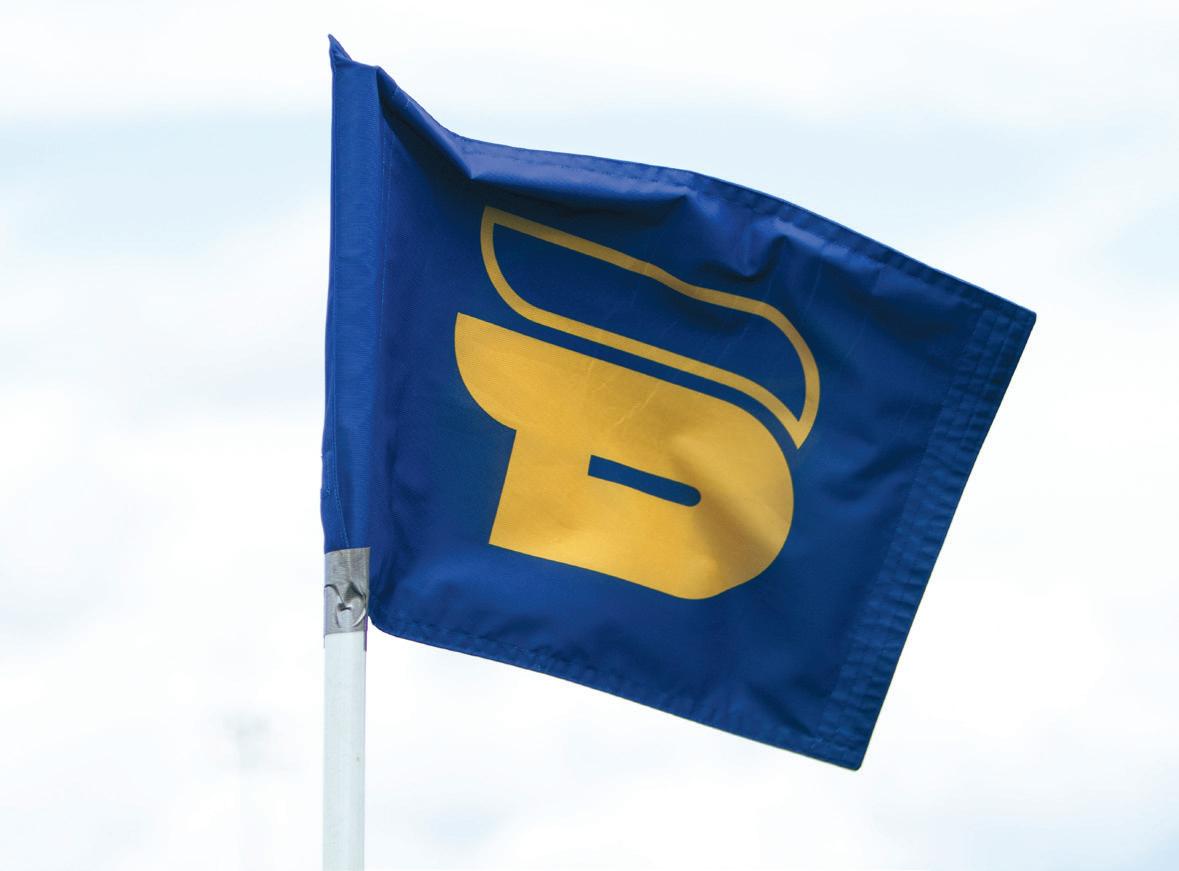
WANYA-TAMBWE/THE EYEOPENER
able to keep their staff employed or because they were worried about the risk of [COVID-19],” said Pettit. “We said ‘we can manage the risk.’”
With all of its efforts to stay open, Pettit is proud of the department’s work. Not only was there no transmission of COVID-19 in recreational facilities—as reported by TMU in 2022—but a sense of community prevailed. The opening of recreational facilities allowed students to interact with each
other, while department staff had meaningful work to accomplish, maintaining their purpose.
For athletics, even with cancelled games, Asquini was sure sports would return to the university.
“I don’t think I was ever really concerned that sports was or wasn›t going to come back…it was an issue of when and what changes were we going to have to make operationally to make it feasible,” said Asquini.
Read more at theeyeopener.com

By Jerry Zhang
New term, new tabs. These picks can help you plan, focus and breathe between classes without distraction.
Notion—all-in-one planner
Build a simple hub or an everything-board. Notion is a one-stop app that combines notes, to-dos, calendars and databases in one place, so readings, deadlines and group tasks don’t scatter across
apps. Templates from Notion offer structure to make setup quick, and connect with Google and Apple calendars so you can see class events alongside your Notion deadlines. It’s flexible enough to run an entire semester from a single dashboard.
Stanford Storm AI—research jump-starter
Staring at a blank page? Informally, it’s known as “Storm AI,” Stanford’s open-source Synthe -
By Vihaan Bhatnagar
AI is being hailed as a powerful teaching tool, with some studies suggesting it can help them learn faster than traditional teaching. A World Bank Study released in May found that students made substantially higher learning gains when they were supported by artificial intelligence (AI).
The study involved six weeks of daily sessions with Microsoft Copilot, a Large Learning Model (LLM) type AI that operates on ChatGPT-4. The study reported that the gains equal a year and a half to two years of traditional schooling.
Closer to home, some instructors at Toronto Metropolitan University (TMU) have already started weaving AI into their work but only within TMU’s Policy 60, which prohibits the usage of AI by students unless explicitly stated by the instructor.
According to the latest Canadian Student Wellbeing Survey, conducted by YouGov for Studiousity, an academic support provider, 78 per cent of Canadian students surveyed said they had used AI to study before.
Nagina Parmar, an adjunct professor at TMU, is among the educators who allow the usage of AI in their classes.
Parmar, who primarily teaches medical microbiology in the biomedical sciences program, said she implements specific rubrics for students who choose to use AI and requires them to disclose when AI has been used. In a science and policy development class Parmar has taught, students had the option of using AI to assist with role-play exercises.
TMU’s Academic Integrity Office and the Centre for Excellence in Learning and Teaching (CELT) expressed that the use of AI is always at the instructor’s discretion. They added that “whatever the acceptable use parameters are... should be communicated to students clearly in a syllabus or other course policy statement.”
She encourages the use of AI as a tool but she doesn’t allow students to use AI when assignments require critical thinking.
“For the past five or six years, my lectures have been mostly [problem-based learning], where students have to do critical think-
Goodnotes—digital note-taking and study organization
Instead of stacks of paper and countless links, Goodnotes can turn a tablet or laptop into a searchable notebook. You can handwrite on notebooks, annotate PDFs, and keep lecture slides, rubrics and study sheets in one search library. No more digging through D2L course shells to find the right one before midterms.
Otter.ai—lecture capture and meeting notes
time and a visble “don’t doomscroll yet” cue when you reach for your phone. Use it for small study sessions and make sure to take a break in between.
AllTrails—hiking/wellness for off-campus resets
sis of Topic Outlines through Retrieval and Multi-perspective Question Asking (STORM) helps to kick-start research into any topic by pulling web sources into a report. It can draft outlines, explain tricky concepts and point you to sources but treat it as a starting point, not a final answer. Always check facts and cite original materials. It’s a research prototype you can run from Stanford’s demo or the GitHub repository.
Hard time following a fasttalking professor? Try using The Eyeopener’s best friend. Otter can create live transcripts of lectures, meetings and interviews with summaries and searchable notes to scan after. It’s useful for looking back after lecture to find the pesky sections and can save your hand from jotting or typing pages of notes but always ask before recording, and follow your course’s policies, then let your wrists take a break.
Forest—stay-focused timer that feels tangible
The Forest uses the Pomodoro method for studying, start a session, grow a virtual tree and don’t touch your phone but leave early, and the tree withers. Over the weeks, watch your study session become a virtual forest as it offers a more concrete sign of study
AllTrails help you find nearby walks and hikes with maps, photos and reviews. Feeling like being in prison after a long day of sulking indoors, find a short route for a quick reset between classes or plan a longer weekend trip with some friends. Step outside for a break and a refresher before the next block of work.
Shortcuts strings various functions together on the Apple device, short LEGO-like program pieces can be puzzled together to serve various automations serving niche needs. Routine tasks can be made to take only one tap. Compile PDF’s of weekly readings, set an auto pre-lecture focus mode while opening the right notes app, log study hours and timed mindful or journaling prompts. Set it once and save minutes every day.
Check these app out and see what works for you but use free tiers first and upgrade only if a feature clearly helps you every week.
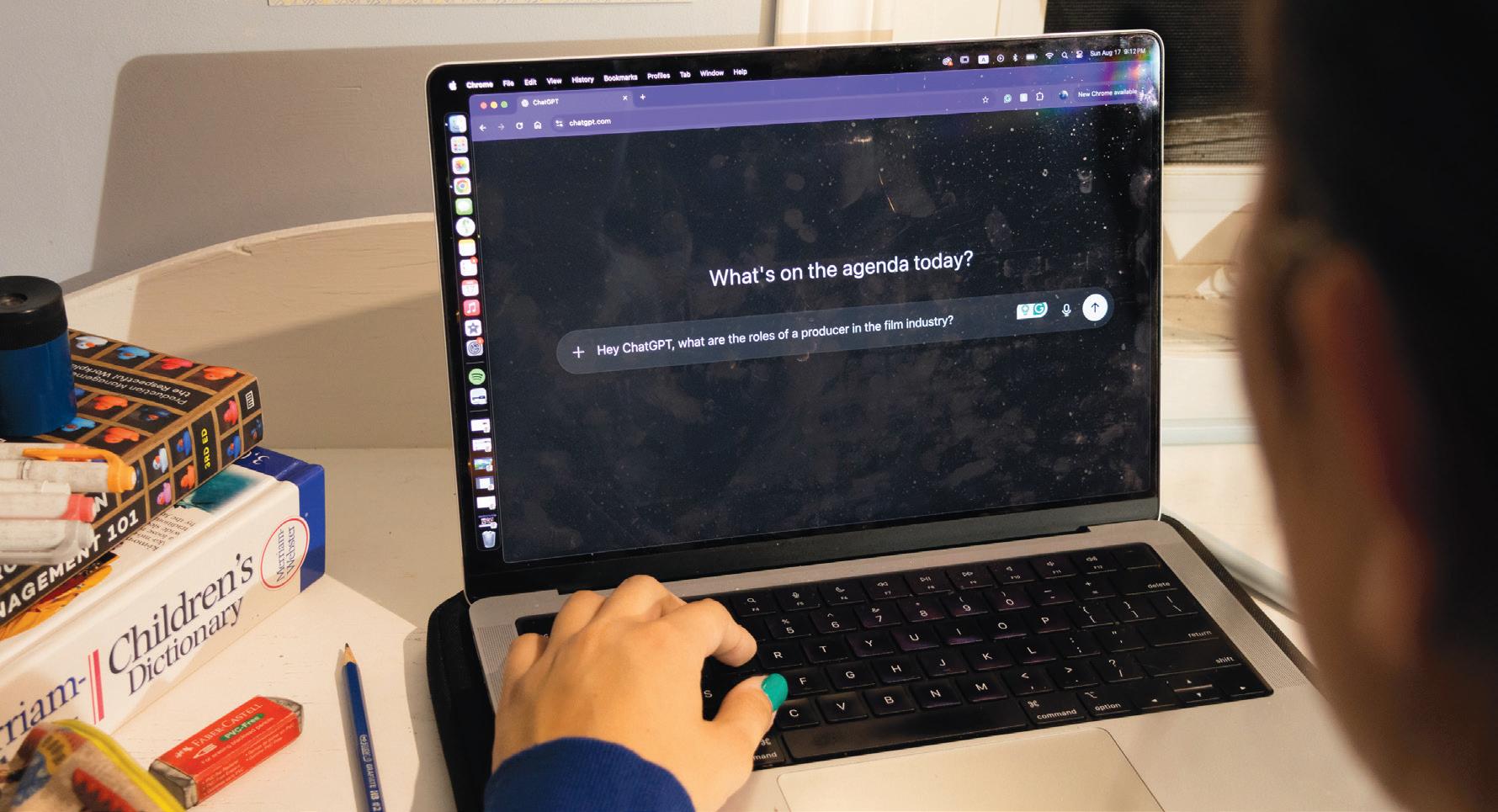
ing,” said Parmar. “Not necessarily just...go to ChatGPT and search the answers, because the cases we studied in the classroom…you have to know the basics as well.”
In one of her classes, Parmar has her students analyze the structure of specific drugs and then talk about it in their own words—an activity in which she said the use of AI would be obvious to her. In this case, the use of AI would be considered a breach of Policy 60, according to Parmar.
Parmar said there are both pros and cons to using AI but cautioned that students who lean on it will “become more reliant, totally dependent on that sort of problem solving and hinder the development of critical thinking as well.”
She added the concern is greatest when they move on to work-
ing professionally and have to craft their own emails and such.
Karim Butt, a fall 2024 graduate from the performance acting program at TMU, said he has used AI to help with schoolwork. He explained that he didn’t plagiarize— only using AI to help him look for sources for an assignment.
According to Butt, using AI for art is really frowned upon in the arts community but many of his peers still use the tool for assistance with schoolwork.
“AI has kind of made learning a bit lazier,” Butt said. “I think it’s a bit dangerous because if AI can teach you everything…why do we have institutions? Why do we have schools?”
He said he doesn’t know enough about professors who use AI but he is against professors handing
over all their responsibilities to an AI tool. “Teaching is best done from human to human,” he said.
Parmar echoed Butt’s point, saying students “need that human connection.” She emphasized that even as companies adopt AI within ethical limits, professionals still interact directly with patients, which keeps human communications essential.
Butt warned that AI “could be the downfall of education,” arguing that the reliance on the technology risks undermining the purpose of schools and professors by introducing an unnecessary middleman.
“If my students are not coming to the class and are not engaged, that means whether I use AI or not, or encourage the use of AI— it doesn’t make any difference,” said Parmar.
By Dylan Marks
Disclaimer: Much like the idea of a trip on the TTC with zero delays, this story is impossibly untrue
Following the decision by the Toronto Transit Commission (TTC) Board in partnership with Toronto Metropolitan University (TMU) to rename Line 1s Dundas Station to TMU Station, it has been announced that the name is changing back to ‘Dundas’ due to a lack of public interest.
The reversal was announced in an official statement from TMU president and vice-chancellor Lohamed Machemi who noted he is totally “not bitter” that nobody cared.
“I don’t even care that we’re changing it back, I mean, we might as well change the name of the school back to Ryerson, who cares about anything anymore?” said Machemi.
The original vote by the TTC to change the name was unanimous which led many to believe that nobody was paying attention during the initial voting process.
New TTC chair Jamaal Myers said he tends to zone in and out of votes depending on who is presenting and what they are proposing.
“When I saw Machemi walk in the room with a large bristol board that had Dundas crossed out and TMU written over it with a magic marker, I made the executive decision to zone out and just vibe,” said Myers.
“Much like my favourite Minecraft creature I was aghast”
Though the vote ended up being unanimous, Myers said he only realized what had been decided after checking his email while on the toilet the following morning.

“I was catching up on the latest internet memes when the notification came up in my inbox that we were switching the name. Much like my favourite Minecraft creature I was aghast,” said Myers.
The decision to revert the name to Dundas Station was made after public reception of the situation was non-existent.
“I kept going up to students on the street and asking them if they had heard the good news but everyone just thought I meant Offset was coming back,” said Machemi.
The Eyeopener took to the streets to talk to students about the decision though few seemed to care or even knew it had happened.
Third-year interior design student
Jordana Elsner said she was completely unaware that this change was even a thing and couldn’t care less about what goes on at the school.
“They could change the name of the school to ‘University of Toronto But Worse’ and I wouldn’t give two shits as long as I’m free to keep getting high in professors’ unlocked offices,” said Elsner.
Fourth-year industrial engineering student Maxwell Griffith said he’s more concerned about the financial implications of the change.
“I just want to know where the money they intended to spend on the project is going to now? Will it go to a good cause or can I just have it?” said Griffith.
An investigation task force has been created with the primary goal of identifying where the $1.6 million TMU intended to spend on the change could have been better allocated.
The Department of Unnecessary Naming Decisions and Signage Spending (DUNDASS) declared that the entirety of the budget formerly assigned to the renaming project will now be deposited via e-transfer to lohamed. machemi@torontomu.ca.
“That $1.6 million is just over three years’ salary for me, and honestly I need it after getting ignored so publicly like that,” said Machemi. “But honestly, like I said, I don’t care what people think about me.”
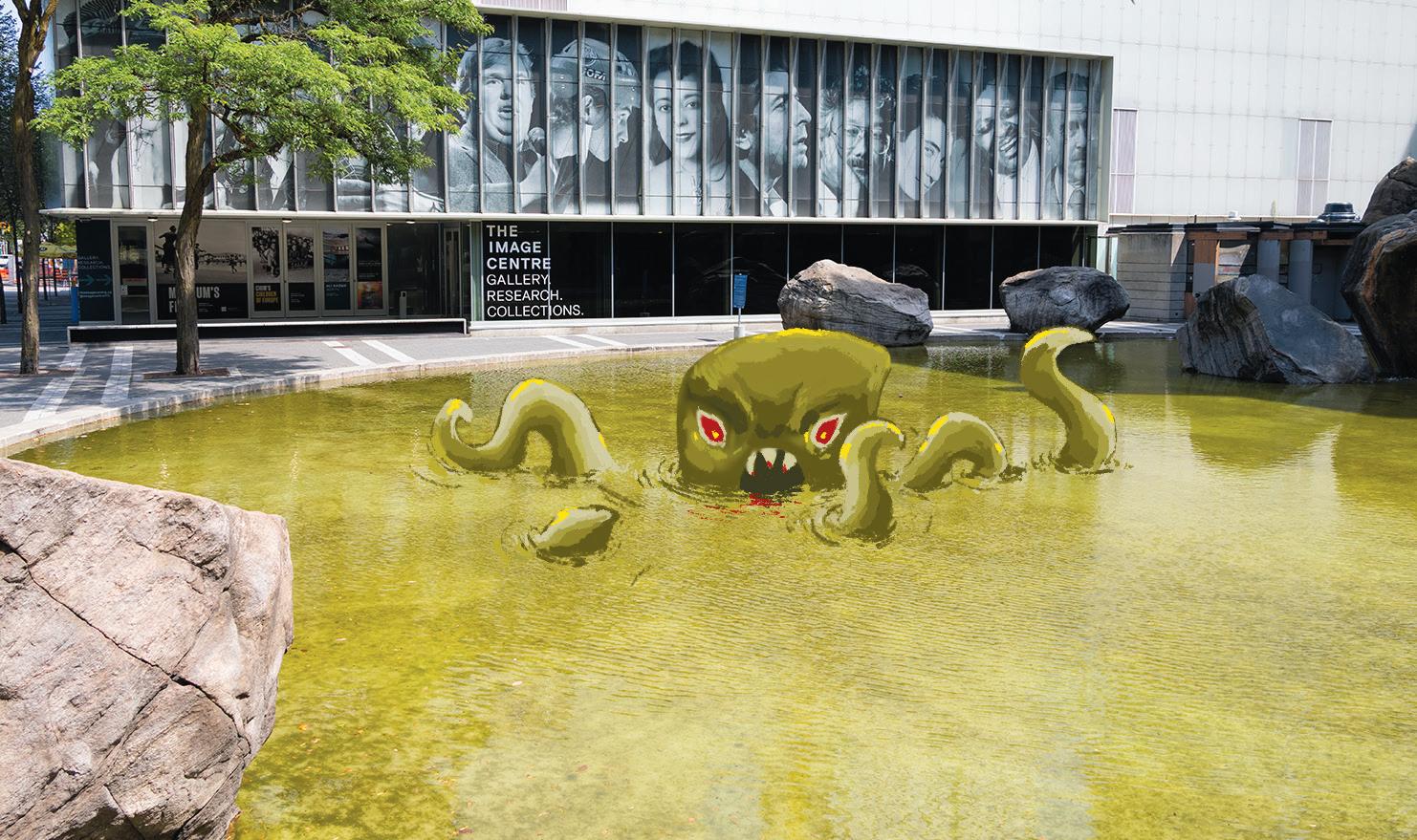
By Edward Lander
Disclaimer: While we cannot confirm whether there really is a creature lurking at the bottom of Lake Devo, we can confirm that there are a bunch of discarded cigarette butts and Tim Hortons napkins in there.
Lake Devo is back on the minds of students this Frosh week and not just because they can’t ignore its smell. But rather because the beloved Toronto Metropolitan University (TMU) water feature has a 12-foot-tall swamp monster living in it.
That’s right—Devonian Pond’s
sanitary situation has become so dire that a supernatural beast of Southern folklore has made its home under the murky surface.
“Something reeked and it wasn’t the Student Campus Centre bathrooms,” said thirdyear nursing student Sam Nguyen. “Then when I saw 11½ feet of swamp monster sticking out of the water, I knew something must have been up.”
Students have been complaining about the dilapidated state of this campus water feature since its creation in 1978 when a meteorite crashed into Gould Street and the university just left the hole there.
Now with word of a potential bog beast living in it, we knew action needed to be taken.
To get to the very shallow bottom of this mystery, The Eyeopener put all of our resources towards locating the creature and uncovering its motives.
“Something reeked and it wasn’t the Student Campus Centre bathrooms”
However, we quickly discovered we could have used just some of our resources because a staff member found the monster on Hinge within the hour.
“I know the best spot in town for: Green algae, mosquito larvae and abducting an unsuspecting passerby into my aquatic nest,” read the monster’s profile.
The monster told us he’s been using the app to search for a mate to accompany him in the “lake,” but has found the dating scene to be much more complicated than it was in his prime—70 million years ago.
“The world of folkloric amphibian romance is not an easy one,” he said. “I got ghosted by a catfish and catfished by a ghost—all in the same month.”
The creature claims there’s more to him than meets the eye and his dates just aren’t seeing this.
“There’s a lot going on beneath the surface,” he said. “No matter how murky and oil-slicked that surface is.”
Some on campus have expressed compassion for the monster over this matter, claiming that rather than fear him, they empathize with his problems.
“While I may not be 12 feet tall, I am eight feet tall. And sometimes it feels like us tall guys can’t catch a break,” said TMU president and vice-chancellor Mohamed Lachemi.
“He’s on the apps? I’m on the apps. It’s tough out there—I get it,” said fourth-year journalism student Edward Lander.
To get deeper into the swamp monster issue, The Eye got in touch with TMU professor Swanson
Monsetter, a specialist who studies species that inhabit swamps.
Monsetter told us that swamp monsters don’t exist. We showed him pictures of the monster, to which he responded “those images have been doctored.”
“I would know, I’m a doctor,” he continued. “Dr. Swanson Monsetter—and that’s no swamp monster.”
We also reached out to the university for comment, asking how they could allow Lake Devo to deteriorate into this state.
“We had planned to deal with the thing a couple years back—but then, like, COVID happened and all that…it was hard for everyone. You get it,” read an emailed statement.
“He’s on the apps? I’m on the apps”
When asked if they were aware of the monster’s existence, the university told us they’ve known about it for some time.
“We are deeply invested in the wellbeing of all those who call our campus home,” the spokesperson wrote.
“We offered S. Monster a double room in Pitman Hall but he chose to decline our offer.”
We asked the monster why he’d decline free accommodations—he had this to say:
“If I wanted to live in a smelly, garbage-filled hole with toilet water up to my ankles, I’d stay right where I am.”